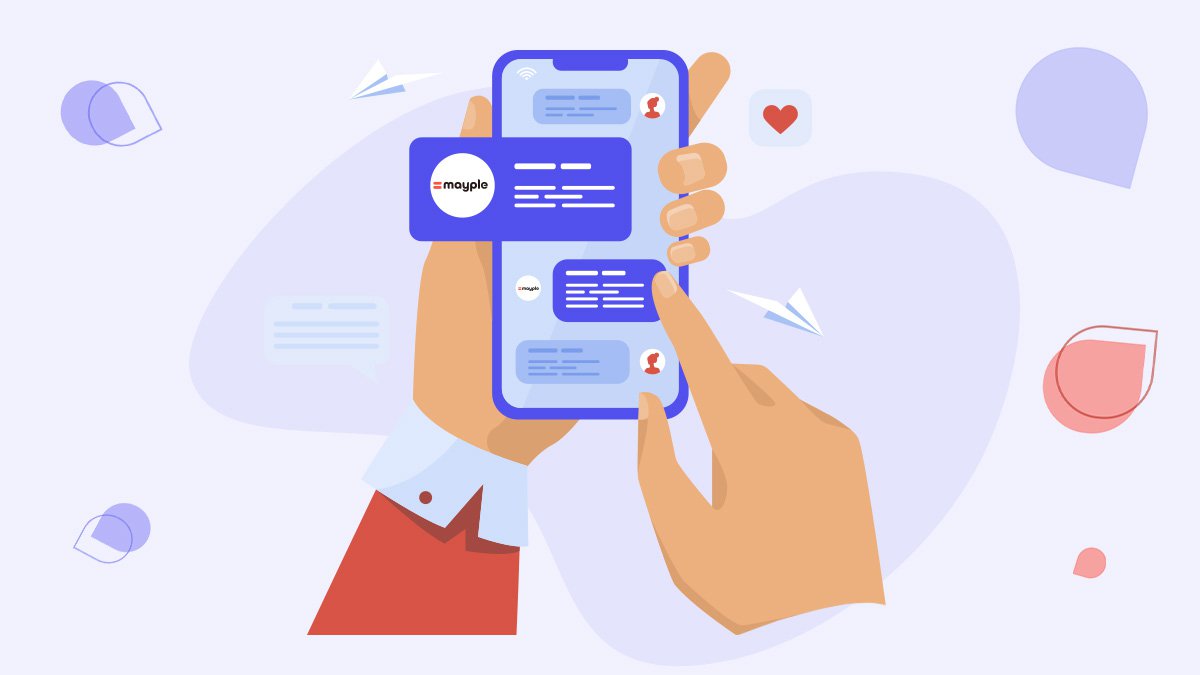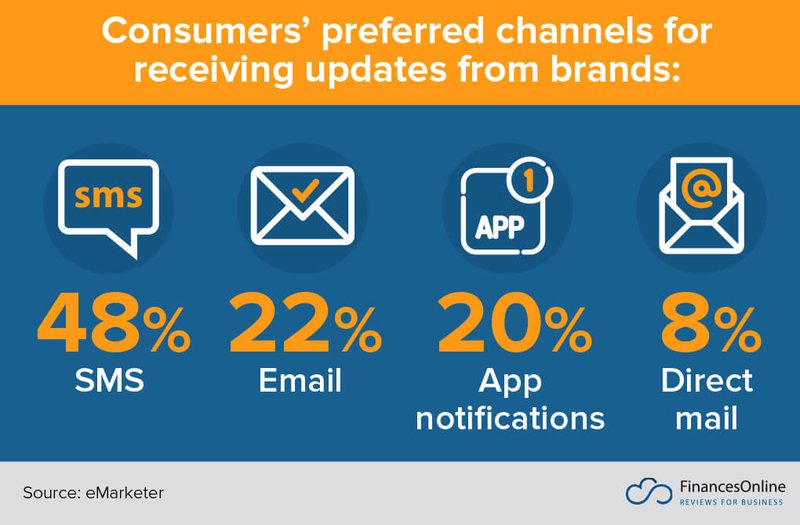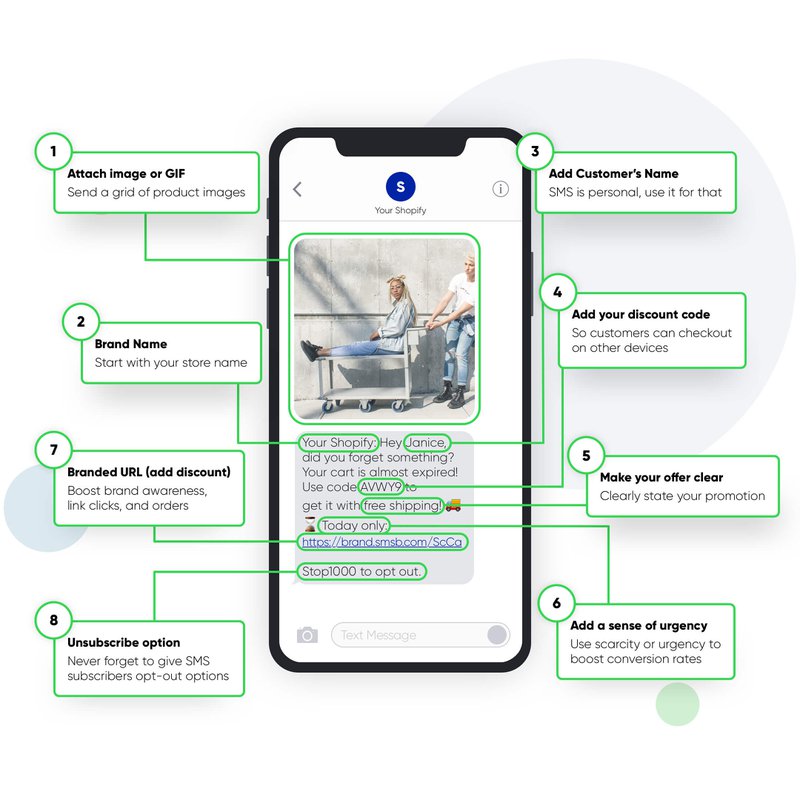9 Conversational SMS Examples to Get You Closer to Your Customers
Catch your audience's attention with text messages that inform, engage, and encourage connection. Learn about conversational sms vs two-way messaging and more.
Updated November 7, 2024

Conversational SMS can be a complete game-changer for your business, and here's why:
Remember your neighborhood grocery store? Where the friendly staff greeted you by name, knew how old your kids were, and even remembered what kind of puppy you were planning to get them for their upcoming birthday?
That personal touch, that sense of connection, made you feel valued as a customer – so you came back again and again.
Things have changed; we have the internet for most of our shopping needs. What we've gained in convenience, we've lost in human interaction.
Conversational SMS can glue back the lost connection. It can help you move past ads, noisy social media, and crowded email inboxes and get closer to your potential customers, tête-à-tête, human-to-human.
How, more specifically, can a conversational SMS marketing strategy help with that?
Let's take a closer look.
What is conversational SMS marketing?
Conversational SMS marketing is a customer-centric approach that uses short message service (SMS) to engage in real-time, interactive conversations.
Unlike traditional marketing techniques primarily focusing on broadcasting messages, conversational SMS marketing emphasizes two-way communication, allowing businesses to understand buyer needs, provide tailored solutions, and build long-lasting relationships.
By leveraging the ubiquity of SMS, businesses can deliver personalized messages and receive instant responses, fostering a sense of connection and trust.
Why is conversational SMS marketing needed?
As it stands today, marketing often needs to improve in terms of genuinely listening to and communicating with customers. Think of it this way: the average consumer sees between 4,000 and 10,000 ads every day. That's more than double what they saw in 2007 and over five times more than the 1970s.
From the moment you open your eyes and walk into the kitchen to the moment you take one last scroll through your TikTok feed, ads and marketing strategies are everywhere.
Are they all successfully grabbing your attention?
No.
But those that do get to you are likely to be the ones that foster meaningful connections – whether through tapping into a pain point you've been having or by making you smile after a long day.
Conversational SMS marketing addresses this issue by enabling businesses to engage with customers actively, understand their preferences, and tailor their offerings accordingly. Companies can create a more buyer-centric marketing approach by shifting from monologues to conversations.
Benefits of conversational SMS
Conversational texting-based marketing isn't a one-size-fits-all solution – but for brands that want to engage with their clientele quicker, more direct, two-way text messaging can be the handshake that marks the beginning of a beautiful friendship.
Some of the most touted benefits of conversational SMS include:
Better customer engagement
Conversational SMS marketing facilitates real-time, personalized interactions, leading to higher customer engagement.
By actively involving customers in conversations, businesses can create a sense of belonging and value, increasing customer loyalty and brand advocacy – the two ingredients that will lower your customer acquisition costs and increase your retention and conversion rates.
Better customer satisfaction
Two-way messaging enhances buyer satisfaction by actively listening and responding to customer queries and concerns. This way, buyers feel heard and valued when their questions are answered promptly, leading to a positive brand perception and improved overall satisfaction.
More personalization
eCommerce conversational SMS marketing allows businesses to tailor their messages to individual customers, creating a personalized experience. By leveraging customer data and preferences, companies can provide relevant recommendations, exclusive offers, and customized solutions, fostering a deeper connection with buyers.
Pro tip: Want to personalize your campaigns? Learn how to make email and SMS work together.
Easy to scale
With the help of eCommerce automation and chatbot technologies, conversational SMS marketing can be easily scaled to reach a large customer base. Automated responses and workflows allow businesses to handle high volumes of conversations efficiently, ensuring that no client inquiry goes unanswered.
The key is ensuring you use a good tool to send your automated text messaging campaigns. Look for something that provides you with a balance between:
- Cost
- Reliability
- Features
Cost efficiency
Conversational SMS marketing offers a cost-effective alternative to traditional marketing channels. Compared to other mediums like TV, radio, or print advertising, SMS campaigns are more affordable and can generate higher response rates, maximizing return on investment.
Generally, SMS marketing will cost between $0.01 and $0.05 per message, and the ROI can be as high as $8.11 per message. In some cases, brands report SMS marketing ROI as high as 115X.
Advantages for customers
Conversational text marketing is beneficial for your buyers too. Some of the advantages many consumers see in receiving marketing messages include the following:
Convenience
SMS messages are instantly accessible on mobile devices, making conversational SMS marketing a convenient channel for customers to engage with businesses. It allows them to interact with brands on their terms, at their preferred time and place.
Pro tip: Use an SMS short code to help customers to interact with you. For example, Chipotle used “TREAT” for Halloween and “DORM2” for college text promotions.
Security
SMS is a trusted and secure communication channel, providing customers with security when conversing with businesses. This reassurance increases trust and willingness to share personal information or make transactions.
Furthermore, SMS can also be used as a double-authentication method, which can improve your overall security (and thus, your buyers' trust in how you manage their personal information.)
Easy opt-in/opt-out
Conversational SMS marketing respects customer preferences by providing hassle-free opt-in and opt-out mechanisms. Buyers have control over their engagement with the brand, allowing them to choose the level of interaction that suits them best.
Makes them feel heard
Conversational SMS marketing empowers customers by giving them a voice. By actively listening and responding to their queries, concerns, and feedback, businesses make buyers feel valued and heard, leading to a stronger brand-customer relationship.
How conversational SMS marketing works
A proper SMS strategy relies on the seamless integration of technology and human interaction. Businesses can leverage chatbot solutions to automate initial responses and handle common inquiries while reserving human intervention for more complex or sensitive matters.
The process typically involves the following steps:
- Building a contact database – Businesses collect customer phone numbers through opt-in forms, purchase lists, or other consent-driven methods to build their contact database.
- Segmentation and personalization – Utilizing buyer data, businesses segment their audience based on demographics, preferences, or past interactions. They then craft personalized messages that resonate with each segment.
- Triggered conversations – Conversations can be triggered based on specific events or customer actions, such as welcome messages, abandoned cart reminders, or order follow-ups. This ensures timely and relevant communication.
- Automation and chatbots – Chatbots can be deployed to handle routine inquiries and provide instant responses. Advanced chatbots can understand natural language, improving the conversational experience for clients.
- Human intervention – For more complex queries or sensitive issues, human agents step in to provide personalized assistance and resolve customer concerns. This combination of automation and human touch creates a seamless and efficient communication process.
Difference between traditional and conversational SMS marketing
Traditional SMS marketing often follows a one-way communication model, where businesses send promotional messages without expecting or encouraging responses. While traditional SMS campaigns can be an effective marketing channel in many ways, their focus is primarily on broadcasting information rather than engaging in meaningful conversations.
In contrast, conversational SMS marketing prioritizes two-way communication, actively seeking customer engagement and feedback. Businesses can better understand customer needs, tailor their offerings, and foster stronger connections by creating a dialogue.
Think of traditional vs. conversational SMS marketing like TV vs. YouTube. Both channels allow you to broadcast video messages – but no matter how much you "comment" on what's going on behind the TV screen, no one will see or respond to your remarks.
On YouTube videos, however, you can comment and even communicate with the creator to engage in an actual conversation.
Difference between conversational marketing and two-way SMS
While conversational SMS marketing and two-way SMS share similarities, they have distinct differences worth considering.
Two-way SMS refers to the ability to send and receive messages through SMS, allowing customers to respond or initiate conversations with businesses. It serves as the foundation for conversational SMS marketing beyond simple two-way communication.
Conversational marketing encompasses chatbots, SMS automation, personalization, and proactive customer engagement to create interactive and personalized conversations that drive customer satisfaction and business growth.
So, in some ways, conversational text marketing is the "evolved" version of two-way SMS marketing.
Conversational SMS campaign examples
Not sure how a conversational SMS campaign could look like? Here are some examples to inspire you:
Welcome campaigns
Upon subscribing or signing up, customers receive personalized welcome messages introducing the brand, expressing gratitude, and providing helpful information.
Example:
"Hi [Name], welcome to our family! We're so excited to have you with us. To get started, reply 'help,' and one of our experts will gladly assist you."
Reminder texts
Businesses send timely reminders to customers about appointments, events, or upcoming sales, reducing no-shows and enhancing customer engagement.
Example:
"Hi [Name], this is a reminder that your appointment with us is next Tuesday at 3 PM. We look forward to seeing you there!"
Feedback requests
Businesses use automated messages to ask for customer feedback, helping them improve their services and products.
Example:
"Hi [Name], get 5% off on your next order by replying to our quick, two-minute survey about your experience at [Business Name]."
Abandoned cart messages
When customers abandon their shopping carts, businesses can send automated SMS messages to remind them of their unfinished purchases, offer discounts, or provide assistance to facilitate conversion.
Example:
" Hi [Name], we noticed you left something in your cart. Did you need help with anything? Reply 'help,' and one of our experts will assist you."
Up-sells & cross-sells
After a successful purchase, businesses can leverage conversational SMS marketing to recommend related or complementary products, increasing average order value.
Example:
"Hi [Name], we noticed you purchased [Product Name]. Did you know our [Related Product Name] is also on sale for 15% off? Reply 'yes' to add this to your order!"
Product recommendations
Businesses can send personalized product recommendations via SMS based on customer preferences and browsing history, enhancing customer experience and driving conversions.
Example:
"Hi [Name], we think you'll love these products. Enjoy 10% off your purchase when you reply 'yes' and place your order now!"
Transactional/order follow-ups
After a customer completes a transaction, businesses can send order confirmation messages, shipment updates, or request feedback, ensuring a smooth and satisfactory customer journey.
Example:
"Hi [Name], your order is on its way! We'll notify you as soon as it's been delivered. In the meantime, please reply with any questions or concerns."
Customer service updates
In case of service disruptions, delays, or changes, businesses can proactively notify customers through SMS, providing real-time updates and maintaining transparency.
Example:
" Hi [Name], your [Business Name] customer support ticket has a response. Check it out here or reply with 'No' if you don't want to receive updates."
Re-engagement
For customers who have been inactive or dormant, businesses can send re-engagement messages to spark interest, offer incentives, or provide relevant updates, rekindling their engagement and loyalty.
Example:
"Hey [Name], add voucher COMEBACK to checkout on [Business Name] and get 10% off your next purchase. "
Tips for successful conversational messages
Conversational text messaging does not have to feel like rocket science. With the right SMS tools and a solid strategy, conversational messaging will take your business closer to your buyers. Here are some tips to make sure this actually happens.
Remember they're actual conversations
There's a reason they call it "conversational text messaging" – it's meant to sound like a normal, human dialogue. Treat SMS interactions as genuine, maintaining a friendly and conversational tone to establish customer rapport.
Allow customers to reply
Encourage clients to respond and actively engage with the messages they receive. Respond promptly and provide helpful, personalized assistance to foster a positive customer experience.
Personalize them
Leverage buyer data to personalize SMS messages, addressing customers by name, tailoring content based on their preferences, and offering relevant recommendations or promotions.
Make sure you have consent
Ensure compliance with applicable regulations and obtain proper customer consent before initiating SMS communications. Respect their privacy and preferences at all time – there's no "conversation" in SMS business messaging distributed to people who did not consent to be on your SMS list.
Conversational SMS: It's time to have a chat!
We've grown too accustomed to marketing that feels like a monologue – so much so that many brands need human-to-human dialogues that bridge the gap between them and their customers.
Conversational text messaging can help with that. A smart messaging app and automation technology can provide a forum for one-on-one, real-time conversations that feel as close as the ones you'd have in the neighborhood bakery.
Ready to leverage SMS marketing? Hire an expert SMS marketer with Mayple. Contact us, and we'll match you with the best expert in your niche in a matter of days!








![How to do a SWOT Analysis The Right Way + [Free Template]](https://entail.mayple.com/en-assets/mayple/fit-in/280x280/634eafb224053437d14c9270_swotanalysistemplate_1f4242b19e98251e92387497f847801e_2000-1699775582876.png)
